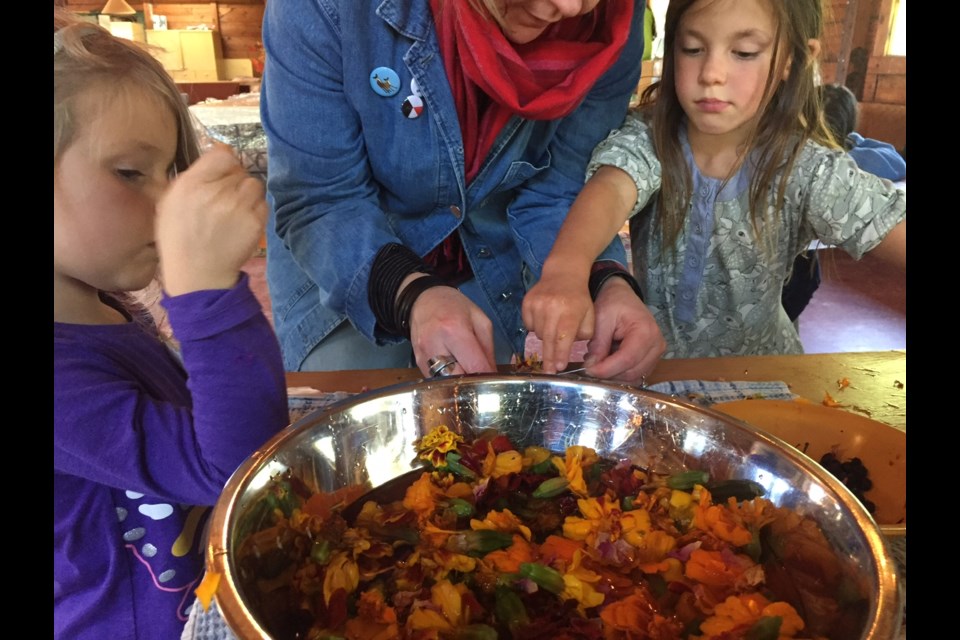Two local arts organizations are stitching together their love of community into an art project that will be shared around the dining room table for years to come.
Algoma Traditional Music and Dance Group (AlgomaTrad) and Thinking Rock Community Arts are working with community members of all ages and experiences to create table runners.
Participants were asked to sew sampler squares from fabrics and fibres dyed using plants from a natural dye garden that will be fashioned onto fabric strips to complete the runners. They will be used in the group’s dining hall.
“We thought wouldn’t it be nice to make something that everyone can enjoy when they come to AlgomaTrad and feel they were a part of it,” said Julie Schryer, AlgomaTrad co-founder and co-artistic director.
“We have a lot of programming centred around food. It’s really important to us when we run an event that we have food and a gathering where people can celebrate and connect through eating together, so it made perfect sense for us to do the runners.”
AlgomaTrad is a non-profit organization that offers programming in traditional music, dance, arts and heritage craft. This includes concerts, festivals and camps on the 50-acre former Algoma Music Camp property on St. Joseph Island.
The table runners celebrate the bounty from Algoma Trad’s dye garden by using materials dyed from the plants and the land around the centre.
The building of the dye garden began in the summer of 2019 and continues to grow with the help of local artists, community volunteers and the St. Joseph Island Horticultural Society. It is supported by funding from the Ontario Arts Council.
The garden provides sources for natural dyes and pigments for art classes, workshops and community art projects. It includes sunflowers, marigolds, dyer’s coreopsis and dyer’s cosmos.
The idea behind the garden is to provide artists and students with an opportunity to create deeper connections with nature and gain an appreciation for traditional ways of creating art.
“Our whole purpose was to engage artists and to connect artists with community and to create learning and sharing and the passing on of skills,” said Schryer.
“We want to work with nature and not against nature. We want to have the least harmful effect on the planet. Using natural dyes also helps people to connect with nature and that’s a huge value with AlgomaTrad – the environmental awareness and conservation.”
Miranda Bouchard is a local artist who helped establish the garden and is supporting the table runner project. She is the artistic director of Thinking Rock Community Arts, an organization that provides arts programming and community-engaged art projects, based in Thessalon.
“We were very interested in the idea of establishing a dye garden,” she said.
“It’s for the environmental benefits, but also to be able to have access to natural dyes which have been used for generations and to reconnect with identifying and appreciating plants both for their beauty, but also for their practical and traditional and medicinal uses.”
About 60 table runner kits were prepared by Bouchard. They included everything needed to stitch a sampler square – embroidery floss, bits of naturally-dyed fabric and yarns, an embroidery needle, a wool square, a pencil and square of paper, a stitch guide, and instructions.
“The squares are going to be just the right size to be placed on the runners. The runners and the squares will include buttons so they can be buttoned or unbuttoned together to easily dress tables of any size,” said Bouchard.
The physical runner is a strip of fabric that’s been naturally dyed, and the squares are meant to be a vessel.
“They could make an abstract sampler to try out different embroidery stitches working with the materials in the kit or a creative landscape where the flowers and landscape are shown of where some of the natural sources of dyes have come from,” said Bouchard.
Bouchard, along with other local artists, Tuija Hansen and Mary Schneider, taught natural dye classes at AlgomaTrad and looks forward to how the garden will generate new possibilities for learning and connecting to heritage craft and community.
“It’s been a labour of love,” said Bouchard. “It’s been a really good project for the organizations to be able to work on together. This way of working where we’re centring heart and centring art is really great.”
